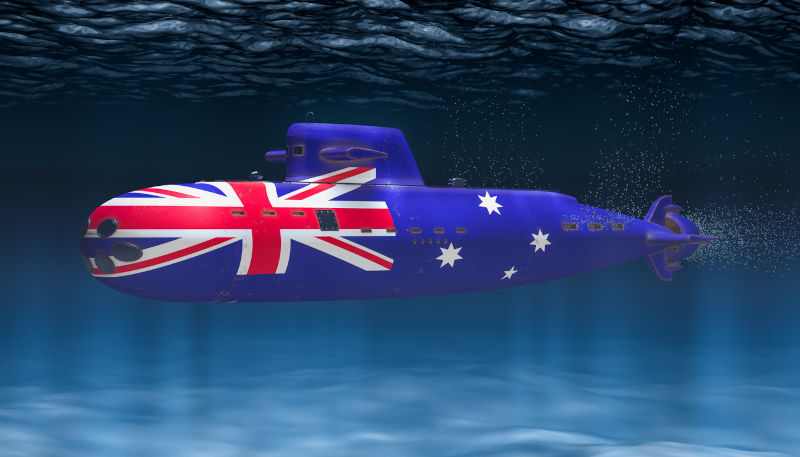AUKUS submarines will be highly detectable and therefore strategically useless.
The loss of the tourist submersible intending to view the wreck of the Titanic captured the attention of many.
Ignoring the highly questionable elements of that situation, lessons have escaped the notice of some people who should have been looking with horror at the unfolding of events: our government and defence heavies currently invested to unfathomable degrees in the progress of AUKUS.
It would be a triumph of hope exceeding reality to believe our Minister for Defence and our Prime Minister understand the implications of certain aspects of what transpired.
Considerably after the implosion, the US Navy confirmed that it had identified its occurrence and its approximate location – along with a rather coy notice indicating limited details released due to concealing acoustic capabilities. Since it happened somewhere around 600 miles off Newfoundland and the activity had no potential strategic/tactical military impact, here are a few of the major take-aways of that announcement:
- the US Navy continuously monitors vast areas of the oceans of the world
- this monitoring has multiple receiver points allowing triangulation of location to fairly accurate limits without restrictions imposed by depth
- that the recognition of noise sources is sufficiently advanced to be able to identify an implosion (pretty rare, not many submersible craft have reached crush depth catastrophically in recent times, vs various explosions e.g. the Kursk).
Most people who have had any exposure to the realities of undersea warfare would not be surprised. This stuff has been publicly known for a long time.
Between 1996 and 2004 I consulted to a number of organisations on a range of topics including the development of computer-based training on acoustic and magnetic tactical procedures to avoid detection and to enable recognition of threats. This was for the purpose of on-board learning ‘in the field’ (i.e. on patrol) for fighting ships.
My previous (though probably lapsed) Top Secret clearance may have contributed to the degree to which I was allowed access to the course ‘materials’ (acoustic profiles, in the main). While I am quite sure that no breach of restrictions on access to such information happened, I will refrain from supplying too much detail.
We (my co-consultant and I) were provided with a number of tapes of identified acoustic noise, to be used as training aids. No precise information on how, where or when they were collected was provided, just descriptions of what they were with some general context/explanatory data. How you got the data would reveal capability information. and even 20 years ago, the analytical ability of the US Navy was formidable.
It would be naive in the extreme to think that approximately similar capability does not exist for Russia and for China.
In the mid-1970’s, SOSUS was already superceded by NAVFAC and the existence of these major arrays was fairly well known. The (by then) somewhat ‘old’ technique of sending a Poseidon-missile equipped submarine out over the SOSUS/NAVFAC array surrounded by a pack of hunter-killer cover subs to dissuade and confuse Russian equivalents from chasing the big fish was well established, and I believe continued with the Trident class. (Fun fact – there were some reports of USA-vs Russian hunter-killer games of chicken around these circuses, a couple of which may have resulted in contact – boys will be boys).
Particularly for the Tridents, the strategy was to slip down under a thermocline that would tend to blanket the heat and noise escaping from the loitering/resting Trident and return to base months later. Detection was fairly limited by depth, thermoclimatic conditions, and remoteness of location. Magnetic anomaly detection had not, as far as I know, advanced to anywhere near useful against this strategy.
By 2000, I can state without fear of revealing anything substantial, that acoustic detection had advanced to the point where a specific freighter travelling down the coast of Japan, the speed and course it was making, could be identified from probably about San Diego (ish). Not only could that vessel be named, but that the gradual damage to one of its propellor shaft bearings continued to progress even after several years of service was identified.
Probably unidentifiable was what the Captain had had for breakfast, though if it were beans, then maybe…
Twenty plus years later, the likely advances in acoustic, magnetic anomaly and thermal anomaly detection will have been great; laser-aided detection methods will have advanced exponentially from the potential of the early ‘90’s Laser Airborne Depth Sounding (LADS) capability of the ‘90s. Remember that a Canadian Air Force P8 Poseidon reported noises in the vicinity of Titanic at extreme depths…
It is inescapable that the oceans will (may already have) become ‘transparent’ to such large objects as nuclear missile submarines toddling around the place. The Chinese Ambassador’s quip about the proposed AUKUS submarines being ‘sightseeing’ machines is reflected by the detection of the loss of a genuine sightseeing submersible.
When military top brass and Ministers for Defence are slavering over pictures of nuclear submarines and dreaming of models on their desks, rationality is likely to be the first victim of procurement. Experience says one would not task Defence to buy a litre of milk.
When a Prime Minister (or three) feeling insecure about their tenure of office perceives a very visible public deflection, rationale becomes carpet.
AUKUS has to be disbanded on pragmatic grounds, even before we get into alliance issues.

Richard Llewellyn
Richard Llewellyn was Registrar at the Australian War Memorial from 1986 to 1995.
